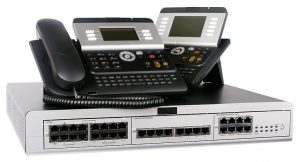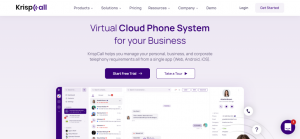You understand that sticking to the same old techniques, tools, and approaches won’t help your company grow. So, why do you use PBX when you can easily migrate it to VoIP?
VoIP allows the user to make use of useful PBX (Private Branch Exchange) services without paying any upfront expenses.
There are so many benefits of VoIP over PBX that we are going to discuss in this article along with the easy steps for pbx to voip migration checklist.
How do you make the transition to VoIP?
You’ll need to contact a VoIP provider to transition from a regular phone line to VoIP. All you’ll need is a strong enough internet connection to make it work. There are 9 steps of migrating PBX to VoIP systems that we are going to discuss in this article.
What is PBX?
A Private Branch Exchange, or PBX, is a physical system that manages call routing and switching between a business site and the phone network. It refers to the numerous organization private telephone networks that companies use to link to the larger network.
How does PBX work?
It is a switchboard operator & the term PBX derives from how it deals with PSTN (Public Switched Telephone Network). Analog, digital, or cloud-hosted are the three types of PBX phone systems.

An analog PBX or landline system connects to the PSTN. A digital PBX takes advantage of internet access and speed to provide modern businesses with more intelligent features at a cheap cost.
A cloud PBX is a hosted digital system, virtual PBX, IP PBX phone system, or VoIP phone that runs fully through the online connection.
What is VoIP?
The technique of delivering audio (voice) and multimedia data via the internet service is known as “VoIP (Voice over Internet Protocol).”
The audio instruction used in traditional phone calls is converted into a digital signal that travels through the Internet through VoIP technology.
How does VoIP work?
A VoIP phone system uses your internet service rather than a traditional landline or cellular network to make phone calls.
Over your broadband connection, a VoIP system turns analog audio impulses into digital signals. Calls are connected to different phone networks via a VoIP server.
PBX vs VoIP
The differences between PBX & VoIP are in the given table below. You can simply decide by knowing what is the difference in terms of different factors.
| Factors | PBX | VoIP |
| Running Cost | The cost of running an on-site PBX is determined by your setup. | The majority of VoIP companies operate on a subscription basis. |
| Security | External calls are routed directly to the PSTN through an on-site PBX. There is no chance of hacking because the system is not connected to the internet. | The level of VoIP security varies depending on the supplier. |
| Multimedia Communication | Only voice calls can be handled by an analog PBX system. | Instant messages and conference calls are both possible with VoIP. |
| International Calls | For overseas calls, phone providers charge expensive minute charges. You must pay conventional phone company charges if your PBX employs landlines. | International calling rates, on the other hand, are typically substantially lower using VoIP. In fact, some VoIP is free for international calls. |
| Scalability | Scalability is not as simple with PBX. You’ll need to add more phone lines as well as new equipment. A fully new PBX system is required for new workplaces. | With VoIP, a call center’s technology can be scaled quickly. |
Advantages of migrating from PBX to VoIP phone System
In the internet era, everything is connected and operated by internet connection. Here are some of the benefits you’ll get when you migrate from PBX to VoIP Technology.
- Accessibility improvements: Accessibility is the most major advantage of VoIP for businesses. Cloud-based VoIP services have the advantage of allowing users to make conferences from any location.
- Scalability is increased: Scalability is a feature of VoIP that makes it appealing to growing businesses. As your business grows, a VoIP system eliminates the need for expensive equipment or a dedicated line.
- Reduced expenses: Every cost-cutting opportunity must be considered. Businesses can gain tremendous cost reductions by implementing a VoIP phone service. In a traditional phone system, a company must pay a huge amount of cost upfront.
- Multitasking is facilitated: In addition to typical phone conversations, VoIP allows you to share documents, photos, and videos while having a chat. So, VoIP supports multitasking.
- Improved voice clarity: Calls on VoIP are typically crisp and clear, with no delay, lag, or call dropouts. We’ve all suffered through a terrible voice and video conference when we used the traditional phone system.
- Enhanced Security: VoIP can help to avoid such protection risks by utilizing IP technological developments such as encryption and better identity management.
Those are the reasons why you want to migrate your PBX system to business VoIP. But before setting up business VoIP you need to understand several strategies.
We hope you know the advantages of moving your business from PBX to a VoIP phone system.
Finally here are the comprehensive PBX to VoIP Migration Checklist you need to follow in order to switch to a business phone system.
PBX to VoIP Migration Checklist: 9 Steps to Switch to a Business Phone
When you follow the checklist and steps below, it will be easy to switch from your PBX to the modern VoIP phone system. The steps are:
1. Planning
Changing your PBX system to business VoIP is a huge task. Don’t make the transition to VoIP without first ensuring that you have the proper infrastructure and training in position. It all starts with making a plan.
2. Examine Your Networks
A network review must be planned before a VoIP migration can be considered. It can assist you in ensuring that your existing network can support voice traffic without degrading audio quality or causing disruptions.
Employees might experience voice lags or even call interruptions as a result of network slowness.
To eliminate interruptions and guarantee that calls over IP proceed smoothly, you should optimize your network measurements and, if necessary, add capacity to the WAN.
If your network switches don’t allow Power over Ethernet for operating IP phones and require to be upgraded, consulting your equipment manufacturers for a network inspection could be useful.
Virtual LANs or, at minimum, a dedicated subnet for VoIP phones will become an essential requirement if your voice traffic is likely to be significant.
Businesses should analyze their networks and calculate their voice traffic in the sense to design a network upgrade accordingly.
3. Selecting the Most Appropriate Service Provider
Employing the proper telephony provider will go a far toward making your Business VoIP successful. It’s very critical for you to take the time & look for a service provider who will listen to your requirements and meet them.
The product that includes IP phones, numbers, and connectivity, as well as other apps and project management, can relieve you of a lot of stress. So, you need to select such service providers who offer you those products.
Aside from certificates and the most up-to-date equipment, look for a supplier who has experience extending the VoIP network to match your growing needs. At every stage of the migration, a team of competent professionals will assist you in making decisions.
This step is very crucial for migrating PBX to VoIP business.
4. Select appropriate VoIP devices
We need to choose the most appropriate VoIP hardware that is suitable for your VoIP business.
You can go with VoIP phones if you want to maintain your desk phone arrangement. VoIP headphones can be configured if you wish to be hands-free. A VoIP softphone is the best solution for using internet-connected devices that you currently own (such as an iPhone running iOS).
5. Creating a Special Interdepartmental Team
You should acknowledge organizing a cross-functional workgroup from several sectors within your firm, such as IT, HR, and the management team while developing the entire migration strategies. It should involve networking specialists and non-technical individuals such as sales and customer service.
As interaction is crucial at both the interdepartmental and intradepartmental levels, this will guarantee that every department’s needs are incorporated into the final migration strategy.
6. Developing and Implementing a Migration Strategy
After you’ve chosen a VoIP service provider and formed an interdepartmental workgroup, you’ll need to create a detailed business plan in partnership with the provider to perform the migration.
Everything requires to be pre-planned to avoid any unexpected happenings during the migration operation, from determining migration expenses and available people and capital resources to predicting a deadline for finishing the complete procedure. Instead of a complete revamp, a group of specialists will attempt to make the move in stages.
A skilled and trustworthy supplier will also assist you in making educated decisions and offer advice to make the move as smooth as possible. Contingency planning is another crucial consideration at this time.
Both data and voice traffic are routed through a single network with Business VoIP, and if the network goes down, all interactions are stopped. In addition, your supplier should create a call center disaster recovery strategy ahead of time.
7. Organizing a Workshop
It’s critical to educate your employees and network manager in advance so that they can swiftly adjust to the fresh VoIP technology once it’s installed.
At the user level, the greatest IP phone technologies will make VoIP seem and feel like a traditional phone system. A user-friendly and simple-to-use IP phone system may significantly reduce the learning time, allowing your employees to get the most out of the new system with less effort.
Don’t be afraid to request that your provider document the entire procedure. You should make sure that your IT team closely watches the entire process and is fully aware of the VoIP system’s maintenance needs.
8. Evaluate your Security needs
It’s crucial to realize that VoIP will be connected to a similar network as your data and other enterprise systems. As a result, it’s critical to give attention to new security risks.
Every unwanted attack on the network system has the potential to harm your data as well as disrupt your daily interactions. Firewalls are critical for protecting your company’s network and interactions.
If specific departments’ communications are crucial, you might wish to explore with your vendor the possibility of encrypting IP phone conversations for certain.
9. Before the final migration, do a test run
Before entirely discarding your old phone system, give it a test run to ensure that it performs as planned. A test run will help familiarize your employees with the Business VoIP configuration, making the move smoother in the end.
It will provide you and your IT staff with an understanding of the problems your employees could experience after the installation is finished. It will enable you to design an approach for dealing with such challenges successfully.
To guarantee that every part of the VoIP system is evaluated and declared trustworthy, your IT staff should design test cases.
Even though there is no one-size-fits-all solution for each company’s specific requirements, following these easy steps will ensure a smooth transition to VoIP from PBX.
Confidently Switch to VoIP with KrispCall
Are you eager to upgrade to an emerging VoIP phone system? With KrispCall, you’ll not only get a more feature-rich communications tool but also discover how easy it is to set up. Your business won’t experience interruptions when you switch to krispcall’s cloud phone system.
The Cloud Telephony service from KrispCall is a low-cost alternative to traditional phone systems. You don’t have to go through it by yourself. We’ve got you covered with our onboarding and quick online setup. You can move your phone system to the cloud in a couple of minutes.

KrispCall is the emerging cloud-based VoIP system that allows you to handle your private, commercial, and corporate telephone needs. It could be your best VoIP service provider. KrispCall offers you a price plan according to your business level.
You can confidently migrate your PBX system to Business VoIP with the help of KrispCall (emerging service providers) & choose pricing plans according to your business level. Contact krispcall team to know how it is very simple to migrate from your old PBX to our new modern VoIP Telephone system.
To Wind-up
Migrating the PBX system to VoIP will always be helpful for your business. VoIP will be beneficial for your organization from many sides such as cost-saving, quality calls, lower cost for international calls, etc.
As we already discussed the things to be considered while migrating from PBX to VoIP system, it will be easy for you to transform PBX to VoIP. You just need to follow every step properly. PBX to VoIP migration will always be beneficial for your business organization.
The best method for PBX to VoIP migration is to select KrispCall as a VoIP service provider that makes calls seamless & effective with its comprehensive call transferring, call forwarding, call masking, and routing functions. KrispCall always makes you competitive in a market.
FAQ
What equipment do you need to switch to VoIP service?
An IP-enabled smartphone or VoIP phone adapter, a router, and internet access are required to switch to VoIP service. You can manage voice calls straight from your laptop or phone with hosted VoIP. You don’t require any further equipment.
How do I switch my landline to VoIP?
By purchasing a VoIP phone or adapter, you can switch your landline to VoIP. Also, for basic and advanced functionality, sign up for VoIP services.
Is VoIP better than PBX?
A VoIP system is less expensive than a traditional PBX since it allows you to add additional lines and devices without having to expand your physical infrastructure on-site. VoIP is better than PBX in other advanced features as well.
Do you need PBX for VoIP?
To use Voice over Internet Protocol (VoIP) successfully, your company does not require a PBX infrastructure. An internet connection and a VoIP phone are the essential needs for VoIP.





